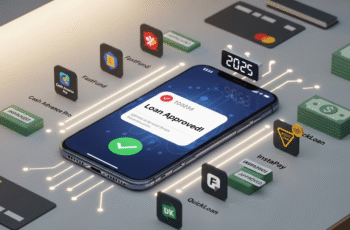Bad credit doesn’t have to mean no loan. This definitive guide reveals the proven strategies, alternative lenders, and inside secrets to secure a business loan—even with a low credit score. Start growing your business today.
Introduction: The Dream Isn’t Dead, It’s Just on a Different Path
Your business idea is brilliant. Your plan is solid. Your passion is undeniable. But there’s a number standing in your way: your credit score.
If you’re reading this, you’ve likely felt the sting of rejection. That sinking feeling when a traditional bank takes one look at your personal credit history and says “no,” seemingly ignoring your business’s potential. It’s frustrating, demoralizing, and can make you feel like your entrepreneurial dreams are over before they’ve truly begun.
Here’s the truth you need to hear: A low credit score is a hurdle, not a dead end.
The lending landscape has undergone a revolution. While traditional banks still cling to pristine credit scores as their primary metric, a new world of alternative lenders, fintech companies, and community-focused institutions has emerged. They look at the whole picture—your business’s health, your cash flow, your industry, and most importantly, your potential.

This guide is your roadmap through that new world. We will not just list lenders who work with bad credit; we will provide a deep, strategic blueprint to not only get you approved for funding but to also rebuild your financial foundation for a stronger future. We’ll cover:
- Understanding the “Why” behind the lender’s perspective.
- Pre-Application Power Moves to strengthen your position.
- The Lender Landscape—from most to least forgiving.
- Crafting a Killer Application that overshadows your credit score.
- Navigating the Pitfalls and understanding the true cost of capital.
- A Long-Term Plan to repair your credit and secure better terms next time.
Let’s turn your financial obstacle into your business’s launching pad.
Chapter 1: Demystifying the “Bad Credit” Business Loan
Before we dive into solutions, we must understand the problem from the lender’s point of view. It’s not personal; it’s about risk management.
What Do Lenders Consider “Bad Credit” for a Business Loan?
While ranges can vary, here’s a general framework most lenders use:
- Excellent Credit: 720 and above
- Good Credit: 680 – 719
- Fair (or “Average”) Credit: 620 – 679
- Bad Credit: 619 and below
If your FICO score is below 619, you are officially in “subprime” or “bad credit” territory in the eyes of most lenders. This includes scores in the 500s and even lower. The lower your score, the fewer your options—but options do exist.
Why Lenders Care About Your Personal Credit (Even for a Business Loan)
If you’re running an LLC or corporation, you might wonder why your personal finances matter. The reasons are simple:
- Thin Business Credit Files: Especially for new businesses or sole proprietorships, there may be little to no established business credit history. Your personal credit is the only data point a lender has to judge your financial responsibility.
- Personal Guarantee: Almost every small business loan, even those issued to an LLC, requires a personal guarantee. This is a legally binding statement that says, “If my business can’t pay this loan back, I personally will.” Your personal credit is a direct reflection of your ability to honor that guarantee.
- Pattern of Behavior: Lenders believe past financial behavior is a predictor of future behavior. Your personal credit report shows how you’ve managed debt, bills, and financial obligations over years.
It’s Not Just About the Number: The Other Factors Lenders Weigh
This is the most important concept to grasp. Your credit score is one piece of a larger puzzle. A strong performance in other areas can dramatically offset a weak score.
- Time in Business (Vintage): A business that has been operating for three years is exponentially less risky than one that opened three months ago, regardless of the owner’s credit score. You’ve proven you can survive the initial startup phase.
- Annual Revenue and Cash Flow: This is huge. Strong, consistent monthly revenue demonstrates that your business has a market and can generate cash. Lenders want to see that you have sufficient cash flow to cover the new loan payments on top of your existing expenses. Most lenders have a minimum annual revenue requirement, often starting around $50,000-$100,000.
- Industry Type: Some industries are considered riskier than others (e.g., restaurants vs. accounting firms). Lenders may have restrictions on certain industries.
- Collateral: Can you offer assets (business equipment, real estate, inventory, or even accounts receivable) to secure the loan? This reduces the lender’s risk because they can seize and sell the asset if you default.
- Business Bank Account Health: Consistent balances, a lack of NSF (non-sufficient funds) fees, and regular deposits all paint a picture of financial stability.
Chapter 2: The Pre-Application Checklist: 7 Power Moves to Boost Your Approval Odds
Do not rush to apply for loans! A scattershot approach will lead to multiple denials and further damage your credit through hard inquiries. Instead, spend 2-4 weeks executing this checklist.
1. Know Your Exact Credit Position
You can’t fix what you don’t know. Pull your reports from all three major bureaus (Equifax, Experian, and TransUnion) via AnnualCreditReport.com. Scrutinize them for errors. Dispute any inaccuracies immediately—this can sometimes lead to a quick score boost.
2. Analyze Your Business Financials
Gather your last 6-12 months of bank statements and financial records. Know your:
- Average monthly revenue
- Profit margins
- Regular business expenses
- Existing debt obligations
This isn’t just for the lender; it’s for you. You must be certain your business can afford a new loan payment.
3. Craft a Solid Business Plan
A well-written business plan is your story. It explains:
- What you do: Your products/services.
- Your market: Who your customers are and the competitive landscape.
- Your team: Who is running the show.
- Your financial projections: A realistic forecast for how you will use the loan to grow and generate more revenue to pay it back.
- The “Ask”: Exactly how much you need and what it will be used for (e.g., “$50,000 for new inventory to fulfill a contract with X Company”).
This document shows you’re a serious, strategic thinker, not someone just looking for a cash lifeline.
4. Strengthen Your Cash Flow
If possible, take a month or two to aggressively improve your cash flow. Collect on outstanding invoices, run a small promotion to boost sales, or trim non-essential expenses. A strong-looking bank statement is incredibly persuasive.
5. Explore a Secured Loan or Collateral
What assets can you pledge? The more collateral you can offer, the more willing a lender will be to overlook your credit score.
6. Consider Adding a Co-Signer
If you have a trusted partner, family member, or associate with strong credit who is willing to co-sign the loan, your approval chances soar. Warning: This is a massive ask, as it puts their personal credit and assets on the line.
7. Build Your Business Credit Profile
Start establishing a separate identity for your business.
- Get an EIN (Employer Identification Number) from the IRS.
- Incorporate your business as an LLC or Corporation.
- Open a business bank account in the business’s name.
- Get a D-U-N-S Number from Dun & Bradstreet.
- Apply for a business credit card or net-30 account with a small vendor and pay it back religiously.
Chapter 3: The Lender Landscape: Where to Actually Get a Loan With Bad Credit
This is the core of the guide. We’ll explore different types of lenders, ordered from generally more accessible to less accessible for bad credit.
Option 1: Online Alternative Lenders (The Most Accessible)
This is where most business owners with credit scores in the 500-600 range find success. Fintech companies use advanced algorithms to assess risk, looking far beyond just a credit score.
- Who They Are: Funding Circle, OnDeck, Kabbage, BlueVine, LendingClub.
- Pros:
- High approval rates for low credit scores.
- Fast application and funding (often within 24-72 hours).
- Less documentation required than banks.
- Cons:
- Higher costs. This is the major trade-off. APRs can be very high (into the triple digits in some cases).
- Shorter repayment terms.
- Best For: Businesses with strong revenue that need fast cash and understand the cost.
Types of Loans Offered by Online Lenders:
- Short-Term Loans: Quick cash, repaid daily or weekly over 3-18 months. High factor rates instead of APR.
- Merchant Cash Advances (MCAs): Not a loan. An MCA provides a lump sum in exchange for a percentage of your future daily credit card sales, plus a fee. Extremely expensive and risky. Only consider this as an absolute last resort.
- Invoice Financing/Factoring: You get an advance on your outstanding invoices. Great for B2B businesses with slow-paying clients.
- Equipment Financing: The equipment itself serves as collateral, making this easier to get with bad credit.
Option 2: Microlenders (The Community Champions)
These are non-profit organizations dedicated to helping underserved entrepreneurs, including those with bad credit or no credit.
- Who They Are: Accion, Kiva, and Community Development Financial Institutions (CDFIs).
- Pros:
- Mission-driven to help you succeed.
- Offer smaller loan amounts ($500 – $50,000), perfect for startups.
- Often provide mentoring and business advice alongside capital.
- Rates are usually very reasonable, often below market rates.
- Cons:
- Slower application process than online lenders.
- May still have credit requirements, but they are more holistic.
- Loan amounts are capped.
- Best For: Startups, very small businesses, and those who want educational support.
Option 3: Credit Unions (The Member-Focused Option)
Credit unions are not-for-profit institutions that can be more flexible than big banks.
- Pros:
- Lower fees and better rates than big banks or online lenders.
- They know the local market and can make relationship-based decisions.
- Often have specific small business loan programs.
- Cons:
- You must become a member.
- Can still be difficult with very low credit scores.
- Best For: Those with fair-to-poor credit who have a relationship with a local credit union.
Option 4: Peer-to-Peer (P2P) Lending
P2P platforms connect individual investors with borrowers.
- Who They Are: LendingClub, Prosper.
- Pros: Competitive rates can sometimes be found. The process is entirely online.
- Cons: Investors on the platform may still be wary of low credit scores, making funding less certain.
- Best For: Those with fair credit (low 600s) looking for a potentially better rate than an online lender.
Option 5: Asset-Based Lending
If you have physical assets, you can borrow against them.
- What it is: Loans secured by collateral like real estate, equipment, inventory, or even your accounts receivable.
- Pros: The focus is on the value of the asset, not your credit score. Can access larger amounts of capital.
- Cons: You risk losing the asset if you default.
- Best For: Asset-rich, cash-poor businesses.
Chapter 4: The Application Deep Dive: Writing a Narrative of Success
Your application is your chance to control the narrative. Don’t let your credit score tell the whole story.
The “Addendum Letter”: Your Secret Weapon
Attach a one-page letter to your application. This is where you explain your credit situation proactively and positively. Do not make excuses. Take ownership and show how you’ve changed.
Structure of a powerful addendum letter:
- Address It Head-On: “I would like to proactively address my personal credit score of 589.”
- Explain Briefly and Honestly: “This was the result of a period of medical expenses/divorce/business downturn in [Year]. This situation was temporary and not reflective of my overall financial practices.”
- Pivot to the Solution: “Since that time, I have taken significant steps to improve my financial health, including [list 2-3 things, e.g., paying down X debt, no missed payments in 18 months, etc.].”
- Focus on Business Strengths: “More importantly, my business, [Business Name], is strong and growing. We have achieved [mention key metrics: e.g., 20% revenue growth year-over-year, $10k in monthly revenue, a new contract with a major client].”
- Reiterate Ability to Repay: “Based on our consistent cash flow and financial projections, we are fully capable of managing the repayment of this loan. The funds will be used directly to [explain use of funds], which will increase our revenue by [estimate].”
This letter demonstrates maturity, honesty, and strategic thinking—qualities every lender values.
Gathering Your Documentation
Have this ready to go. A complete application looks professional and gets processed faster.
- Personal and business tax returns (last 2-3 years)
- Personal and business bank statements (last 6-12 months)
- Year-to-date profit and loss statement and balance sheet
- Business legal documents (articles of incorporation, business license)
- A copy of your business plan
- Details on any collateral
Chapter 5: Navigating the Terms & Avoiding Predatory Traps
Getting an offer is exciting, but read the fine print. Not all money is good money.
Understanding the True Cost: APR vs. Factor Rate
- APR (Annual Percentage Rate): The true annual cost of the loan, including fees and interest. This is the best number to use to compare loans. Example: A 35% APR is high but not uncommon for bad credit loans.
- Factor Rate: Used by short-term lenders and MCAs. It’s a decimal figure (e.g., 1.4) that you multiply by the loan amount to determine your total payback amount. A 1.4 factor rate on a $10,000 loan means you pay back $14,000. This does not correlate to an APR but often equates to an extremely high one (e.g., 80-120%+).
Red Flags of a Predatory Loan
- Vague Terms: If the lender can’t or won’t explain the costs in clear, simple language, walk away.
- Pressure Tactics: Legitimate lenders give you time to decide. High-pressure sales are a major warning sign.
- Upfront Fees: It is not normal to pay an application or processing fee before you are approved and receive funds.
- No Credit Check: A lender that doesn’t check credit at all is likely operating outside the law and offering devastating terms.
- Confusing Contract: If you don’t understand it, don’t sign it. Have a lawyer or accountant review it.
Chapter 6: The Long Game: Using This Loan to Repair Your Credit and Build a Future
Your goal isn’t just to get a loan today; it’s to set yourself up for a better loan tomorrow.
- Make Every Payment On Time, Every Time: This is the single most powerful thing you can do. Your payment history is the largest component of your credit score. Consistent on-time payments on this new business loan will slowly but surely rebuild your credit.
- Monitor Your Credit: Use free services to watch your score improve over time.
- Refinance in the Future: After 12-24 months of successful, on-time payments and business growth, you will be in a much stronger position. You can then refinance your high-interest loan with a new lender offering a lower interest rate and better terms.
- Build Business Credit: Continue using and paying business credit accounts to build a robust business credit profile separate from your personal one.
Conclusion: Your Journey Forward
A low credit score is a snapshot of your past, not a verdict on your future. Getting a business loan with bad credit is absolutely possible, but it requires a shift in strategy. You must move from the traditional banking path to the world of alternative lending, armed with preparation, a compelling story, and a sharp eye for terms.
The journey is about more than securing capital. It’s about taking proactive control of your financial narrative. By choosing the right lender, understanding the cost, and using the loan as a tool not just for business growth but for credit repair, you transform a short-term solution into a long-term strategy for financial health and business success.
Your dream is valid. Your business has potential. Now, go secure the fuel it needs to grow.
Disclaimer: I am not a financial advisor. The information in this article is for educational purposes only. You should consult with a qualified financial professional or accountant before making any financial decisions or taking on any debt.

